
Md Motakabbir Rahman, received his Bachelor of Science (B.Sc.) degree in Electrical and Electronics Engineering from Rajshahi University of Engineering and Technology, Bangladesh. He has been working as a lecturer at Bangladesh Army University of Engineering and Technology since March 2020 (Now on study leave). He is currently working toward MESc. degree at the department of Electrical & Computer Engineering in Western University, London, Ontario, Canada, which is one of the prestigious and top-ranked universities in the world. He is also a member of Free Appropriate Sustainability Technology (FAST) research group, which focuses on the use of open source appropriate technology (OSAT) to find collaborative solutions to problems in sustainability and to reduce poverty under supervision of Professor Joshua M. Pearce.
Research Interest[edit | edit source]
His research interests include photovoltaic energy and power electronics focusing on the open source nanogrid design and control. During his undergraduate studies he worked on the maximum power tracking of solar cells using different neural networks and hybrid techniques. He believes that one-day solar power will dominate the field of electrical power generation, which is currently contributing only about 3% of overall electricity generation worldwide.
Work Experience[edit | edit source]
- Graduate Research Assistant (September, 2022 to Present)
- Western University, London, Ontario, Canada
- Free Appropriate Sustainability Technology (FAST) Research Group
- Open-source DC nano grid design
- Application specific PV system design
- Lecturer (March, 2020 to Present)
- Bangladesh Army University of Engineering and Technology (BAUET), Natore, Bangladesh
- Department of Electrical and Electronic Engineering
- Courses offered: Power Electronics, VLSI, Renewable Energy, Electronics I, Microprocessors and Interfacing.
- Lab-in-charge of Electronic Circuit Laboratory.
- Student Coordinator of EEE Batch 11 (32 students)
- Vice president of BAUET Automation and Robotics Society (Sep. 2021 -Sep 2022)
- Member of accreditation and self-assessment report (SAR) committee.
- Routine Coordinator. (Summer 2021)
- Industrial Trainee (7th May 2018 to 24th May, 2018)
- Walton Hi-Tech Industries Ltd & Walton Micro-Tech Corporation, Gazipur, Bangladesh
- Control of Roll former machine, CNC machine and Injection molding machine used for Refrigerator manufacturing.
- Operating servo motor driver, vector driver and Inverter control using PLC.
- IQC testing of LED Bulb: LED driver testing, LED testing using Spectro-photometer, Life testing.
- Production process and assembly line monitoring LED Bulb.
- 32kV/11kV substation and control room of 15kV diesel and gas power plant visit
Completed Projects and Publications[edit | edit source]
Completed in 2024[edit | edit source]
Modular Open-Source Solar Photovoltaic-Powered DC Nanogrid System
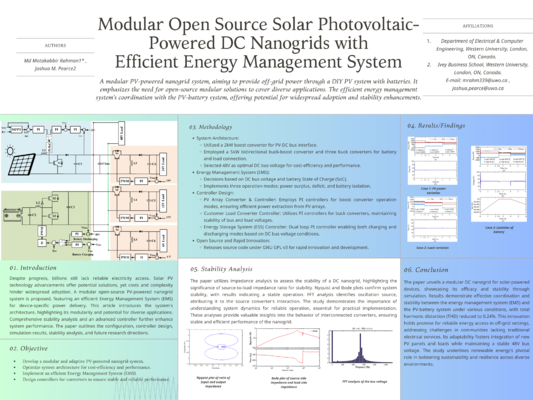
This research presents a modular open-source solar photovoltaic (PV)-powered DC nanogrid system designed for sustainable and accessible off-grid power solutions, particularly in remote and isolated areas. By combining DIY PV technology with batteries, users can generate, store, and utilize electricity, reducing reliance on traditional grid infrastructure and promoting energy independence.
- Modular Open-Source Design: Customizable for diverse applications.
- DIY Approach: Empowers users to assemble and install their PV systems.
- DC Power Supply: Supplies DC power to loads at varying voltage levels.
- Parametric Energy Management System (EMS): Dynamically selects operational modes for efficiency.
- Simulation Validation: Confirms effectiveness in coordinating PV-battery system.
- Customizable Solution: Adaptable for different DC voltages, power levels, and battery backup requirements.
- Open Sharing of Design Specifications: Fosters continuous improvement to meet evolving energy challenges.
HVDC-VSC black start capability in coordination with grid forming solar farm
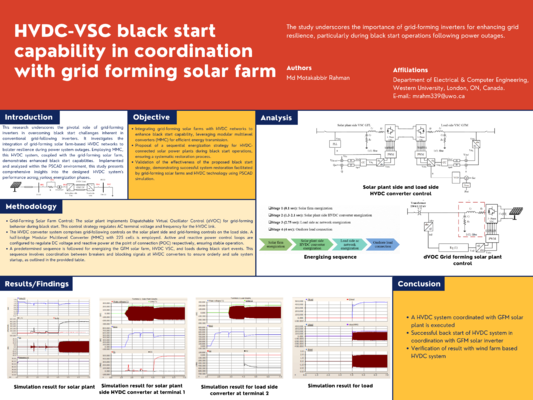
The study underscores the importance of grid-forming inverters for enhancing grid resilience, particularly during black start operations following power outages.
- The research highlights the significance of grid-forming inverters in autonomously establishing frequency and voltage, making them suitable for black start operations and system recovery.
- The study explores integrating grid-forming solar farms with HVDC networks to enhance black start capability, leveraging modular multilevel converters (MMC) for efficient energy transmission.
- A sequential energization strategy is proposed for HVDC-connected solar power plants during black start operations, ensuring a systematic restoration process.
- PSCAD simulations validate the effectiveness of the proposed black start strategy, demonstrating successful system restoration facilitated by grid-forming solar farms and HVDC technology.
- The study identifies avenues for future research, including variations in load conditions, fault scenarios, and automation of blackout detection for improved system reliability and efficiency.
Completed in 2023[edit | edit source]
Utilizing Smart Inverter-based PV STATCOM for dynamic voltage control
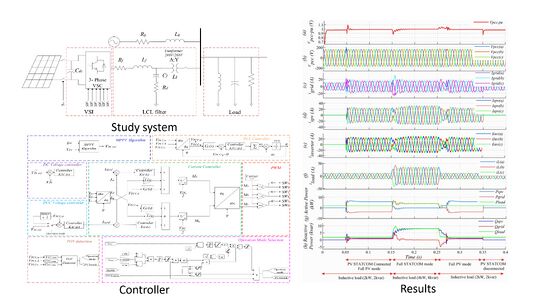
The study system in this project comprises a 10kW PV solar system operating as a PV STATCOM connected to a 208V L-L distributing system.
- Verification of the voltage control performance of PV STATCOM in response to sudden load changes under various scenarios using MATLAB/Simulink
- The system is capable of rapidly exchange dynamic reactive power within 1-2 cycles and supply rated reactive current even at reduced voltage.
- Additionally, provided detailed information about the design of the PV STATCOM controller and guidelines for modeling the system in Simulink environment.
Open-source Inverter (500VA)
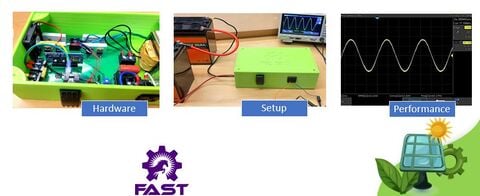
An open source Inverter for 120V, 60Hz AC supply compatible with 24V battery, within the cost of 200 CAD.
- 60Hz 120V pure AC supply
- Open source hardware and encloser
- Over current and over temperature protection,
- High efficiency, low harmonic and low cost
Open-source Maximum Power Point Tracker (30A, 24V)
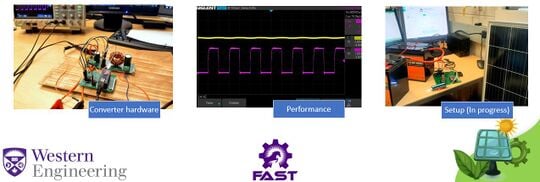
An open source MPPT of 30A,24V designed within the cost of 120 CAD which is poised not only to rival existing market products in terms of price but also to surpass them in certain advanced features such as,
- Features an LCD menu interface with customizable settings and display layouts.
- Offers WiFi connectivity through the blynk app for telemetry purposes.
- Includes built-in protection mechanisms against over current, over voltage, PV short circuit, and battery reverse polarity.
- Equipped with temperature protection and a cooling fan to prevent overheating.
Completed in 2022[edit | edit source]
AC/off-grid photovoltaic powered open-source ball mill
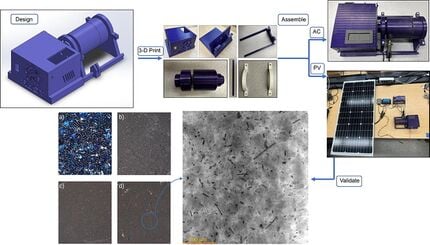
The open-source ball mill is fully customizable and designed to be fabricated with distributed manufacturing. The parametric designs of the main components are 3-D printable on a low-cost readily accessible RepRap-class fused filament 3-D printer, and the electronic parts, bearings, magnets, and balls are provided by a wide-range of of-the-shelf vendors.
- The highly-customizable design of ball mill reduces the cost to <US$130 for an AC powered version and <US$315 for a switchable power that enables off-grid operation with a solar module and battery.
- The open-source ball mill is capable of reducing silicon particle sizes from the millimeter scale down to the nanometer scale.
- The open-source ball mill is also made with standard dimensions to work effectively and has been demonstrated to grind silicon particles from waste PV modules from 0.8 mm to 7 µm in 18 h.
Design and control of dual active bridge converter cascaded with inverter to interface between low voltage DC grid and AC grid
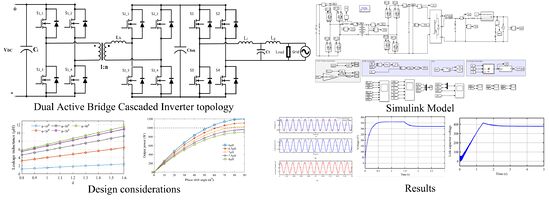
The background of this project is to modify the existing DC nano grid by designing the interface between the nano grid and AC network. The idea is to supply energy to the AC grid when the nano grid is in power surplus mode.
- In this project, the DAB cascaded with inverter topology has been designed which can be attached to a DC grid system as an interface with AC grid.
- Selection of transformer specifications, leakage inductance and conversion ratio in order to achieve ZVS operation for a wide range and reducing switching losses in dual active bridge converter.Hence, this DAB inverter has high efficiency.
- Designing the filters for the grid connected inverter and integrate it with the DAB.
- The simulations showed that, the DC capacitor voltage is maintained within the ZVS range in order ensure soft switching with a wide range of phase shift.
Completed in 2021[edit | edit source]
Design and Simulation of Solar DC Nano Grid System from Bangladesh Perspective
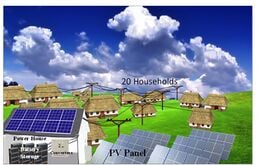
This research project proposes a model of DC Nano grid integrated with solar PV module which can supply electricity to up to 20 households at a distance of about 1 km.
- Solar DC Nano grid can be a possible approach towards achieving electrification to certain areas where grid connectivity is still unavailable.
- It can generate and distribute power to a cluster of households at close proximity reliably.
- I this project simulation results of buck converters assigned to supply power at three different voltage levels to feed various domestic loads.
- The cost estimation is presented of the proposed model.
Completed in 2020[edit | edit source]
PSO and ANN Based Hybrid MPPT Algorithm for Photovoltaic Array under Partial Shading Condition
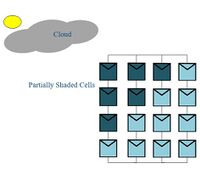
Most of the conventional MPPT methods fail to track maximum power under partial shading condition (PSC). Partial shading is the most common situation in PV power generation, which is caused if part of the series-connected strings is partially shaded. This situation leads to the multiple peaks in the P-V characteristics curve of the PV system.
- Stochastic search method, Particle Swarm Optimization (PSO), is used instead of the conventional methods to track maximum power under PSC. But the PSO method has the limitation of slow operation.
- So in this project, a fast hybrid method is presented, which combines the PSO method with the ANN method.
- In this hybrid method, the ANN enables the existing PSO method to track MPP quickly by providing more accurate initial particle positions of the PSO algorithm.
Completed in 2019[edit | edit source]
Protection of Power System during Cyber-Attack using Artificial Neural Network
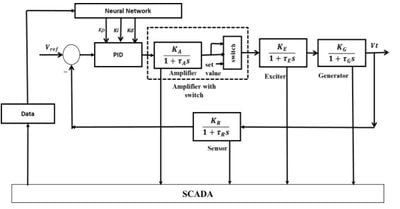
Impacts of frequency and voltage disturbance on an isolated power system caused by cyber-attack has been discussed and a neural network-based protective approach has been proposed in this research work.
- Adaptive PID controllers for both load frequency control and automatic voltage regulator have been implemented using an artificial neural network-oriented by genetic algorithm.
- The parameters of the PID controller have been tuned offline by using a genetic algorithm over a wide range of system parameter variations. These data have been used to train the neural network.
- For load frequency control neural network tuned PID controller mitigate frequency disturbance 48% faster than manually tuned PID.
- For the automatic voltage regulator, neural network tuned PID controller mitigate voltage disturbance 70% faster than manually tuned PID during cyber-attack.
Artificial Neural Network Based Maximum Power Point Tracking of a Photovoltaic System
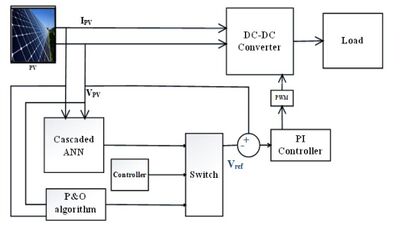
Nonlinear behavior of photovoltaic system under changing environmental conditions, creates the requirement of designing maximum power point tracker (MPPT). Conventionally perturb and observe (P&O) method and incremental conductance method have drawback of slow operation or low tracking efficiency. However, Artificial Neural Networks (ANN) has been deployed for this purpose, as it can track the optimal operating point (MPP) quickly and accurately based on training data sets.
- This paper presents three ANN based MPPT methods: Direct ANN, Cascaded ANN and the proposed Hybrid method.
- The ANN's are trained using training data set of maximum power point voltages (VMPP ) from a user defined PV array over different environmental conditions.
Contributions in Appropedia[edit | edit source]
Literature Review[edit | edit source]
- Literature Review: Open source design of MPPT solar charge controller 30A, 24V
- Literature review: Open source solar power supply unit for plasma generator
- Literature Review on Design and Control of Dual Active Bridge Converter Cascaded with Inverter to Interface Between Nano grid and AC network.
- Introducing DC Nano grid as a modular device with efficient Energy Management System
- Literature Review: DC Nano grid
- Literature review: Development of a direct PV power supply system for an electrolyzer to facilitate the production of green hydrogen
Methods[edit | edit source]
Publications References[edit | edit source]
Journals[edit | edit source]
- M. M. Rahman and J. Pearce, “Modular Open Source Solar Photovoltaic-Powered DC Nanogrids with Efficient Energy Management System,” Solar Energy and Sustainable Development Journal, vol. 13, no. 1, Art. no. 1, Feb. 2024, doi: 10.51646/jsesd.v13i1.169.
- Maryam Mottaghi, Motakabbir Rahman, Apoorv Kulkarni, Joshua M. Pearce, AC/off-grid photovoltaic powered open-source ball mill,HardwareX, Volume 14, 2023,e00423,ISSN 2468-0672, https://doi.org/10.1016/j.ohx.2023.e00423
- Rahman, M. M., & Islam, M. S. (2020). PSO and ANN Based Hybrid MPPT Algorithm for Photovoltaic Array under Partial Shading Condition. Engineering International, 8(1), 9-24. https://doi.org/10.18034/ei.v8i1.481
- Islam, M. S., Sultana, S., & Rahman, M. M. (2019). Protection of Power System during Cyber-Attack using Artificial Neural Network. Engineering International, 7(2), 73-84. https://doi.org/10.18034/ei.v7i2.478
Conference Papers[edit | edit source]
- S. Khan and M. M. Rahman, "Design and Simulation of Solar DC Nano Grid System from Bangladesh Perspective," 2021 International Conference on Automation, Control and Mechatronics for Industry 4.0 (ACMI), 2021, pp. 1-6, https://doi.org/10.1109/ACMI53878.2021.9528159
- M. M. Rahman and M. S. Islam, "Artificial Neural Network Based Maximum Power Point Tracking of a Photovoltaic System," 2019 3rd International Conference on Electrical, Computer & Telecommunication Engineering (ICECTE), Rajshahi, Bangladesh, 2019, pp. 117-120, https://doi.org/10.1109/ICECTE48615.2019.9303531
Awards and Honours[edit | edit source]
- Hydro One Scholarship 2024, awarded for the academic achievement and contributions to Power Systems Engineering at Western University.
- Student of the Year award for the academic year 2018-2019, having attained the highest CGPA of 4.00/4.00 in the fourth year of Bachelor's degree among 120 students at Rajshahi University of Engineering and Technology (RUET).
